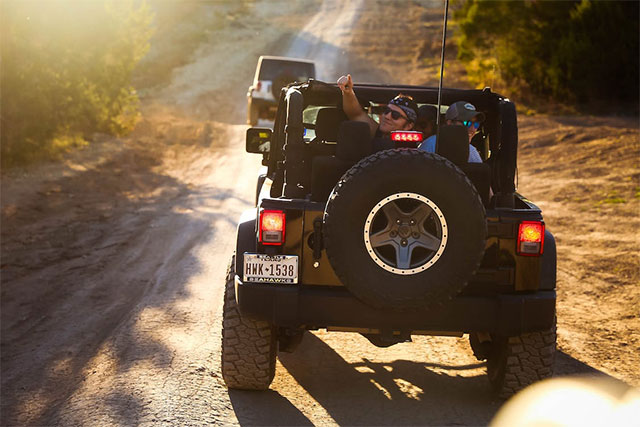For outdoor adventure seekers, taking your rugged Jeep off-road opens up a whole new world of excitement. With the capability to traverse remote trails, navigate challenging terrain, and access stunning natural landscapes off the beaten path, Jeeps promise an unparalleled sense of freedom. However, in order to safely handle the toughest conditions, smart preparation, proper vehicle setup, and responsible off-road driving skills are required.

Follow this comprehensive guide to master Jeep off-roading adventures now you’ve engaged in jeep leasing at firstvehicleleasing.co.uk.
Table of Contents
1. Know Your Jeep’s Technical Specifications
Before hitting the trails, thoroughly understand your Jeep’s off-road capabilities and limitations. Research key specifications like ground clearance, approach and departure angles, 4WD system components, and skid plates. This knowledge allows you to determine the type of rugged routes your particular Jeep model can safely handle based on its design and features.
For example, a Jeep Wrangler Sport with generous ground clearance, heavy duty axles, and 35 degree approach angle can typically climb over larger boulders and handle steep inclines better than a comparably equipped Cherokee which has lower capability measures. Assess your Jeep’s competence.
2. Get Quality Off-Road Tires & Wheels
Investing in specialized off-road tires designed for durability and traction on uneven terrain is highly recommended. Their aggressive tread pattern and stout sidewalls provide a much better grip on dirt, gravel, rocks and mud compared to standard highway tires. Also, make sure to inflate tires to the recommended PSI for off-roading based on your Jeep model and weight rating. Quality off-road rubber makes a huge difference in control.
For especially rugged landscapes, also consider upgrading to beadlock capable wheels which allow running lower tire pressures without risk of de-beading on demanding trails.
3. Use Four-Wheel Drive Correctly
Understand when and how to properly engage your Jeep’s 4WD system, either via a manual shifter, selector dial or control button, to send power to all four wheels. This should be done when enhanced traction is required, such as on slippery inclines, loose dirt or gravel, or when crossing shallow streams and rivers. Avoid simply leaving it in 4WD full-time.
Properly timed 4WD use provides much better tire grip and forward propulsion in low traction conditions but shouldn’t be employed on dry pavement to avoid drivetrain wear. Know when 4WD is called for.
4. Respect Your Jeep’s Approach, Breakover & Departure Angles
These important measures indicate the steepest approach (front) and departure (rear) inclines your Jeep can climb or descend without scraping its bumpers or undercarriage. This helps you assess whether you can safely crest a hill or navigate between boulders without damaging your vehicle. Know the numbers.
For example, if your Jeep Renegade has a 20 degree approach angle, attempting to climb a 30 degree rocky hill risks significant front bumper and undercarriage damage. Respect the limits.
5. Pick Optimal Driving Lines
When traversing challenging trail sections with obstacles, deep ruts and ditches, take time to map the best driving line. Assess the terrain ahead, identify potential high centering or scraping hazards, and chart the safest trajectory through them. Sometimes the longest route that minimizes sharp climbs or side tilts ends up being the smartest versus the direct one.
6. Use Low Gears to Maintain Momentum
When crawling over technical rocky sections or through mud and deep ruts, shift into your Jeep’s low range gears for greater throttle control and torque. Maintaining steady, constant momentum is key. Sudden acceleration or braking can cause abrupt traction loss and leave you stranded. Low gears allow slowly navigating obstacles.
7. Prepare Self-Recovery Equipment
Even seasoned off-roaders can occasionally get stuck miles from help. Always carry essential recovery gear like tow straps, a winch rated for your Jeep’s weight, heavy work gloves, a shovel, tire inflation equipment, and boards or Maxtrax. Know how to safely operate equipment like winches before actually needing to use them.
8. Research Challenging Terrain
Different off-road conditions like deep sand, heavy snow, or water crossings present unique traction, flotation and driving demands. Research terrain you plan to encounter so you can properly equip and adjust your Jeep, tire pressure, gearing and technique accordingly. For example, sand may require lower pressure and locking differentials. Seek guidance from local Jeep groups on best setups and practices for your region.
9. Drive Smoothly and Avoid Damage
Prevent mechanical breakdowns and costly repairs by avoiding overly aggressive driving that harshly stresses your suspension components. Know your Jeep’s limits. Limit abrupt inputs and scenarios causing extreme chassis articulation or damage. Steady and controlled operation helps maximize trail time versus garage time.
10. Respect the Great Outdoors
Adhere to designated off-road trails, avoid trespassing on private property, and practice Leave No Trace ethics. Employ minimum impact techniques to protect vegetation, wildlife and landscapes. Tread lightly so our wild spaces remain pristine for future generations to experience and enjoy.
With in-depth knowledge of your equipment, smart preparation, responsible practices and essential skills, the most challenging off-road landscapes are within your reach in a Jeep. Start slowly on easier trails, be cautious about quickly progressing to hardcore terrain, and avoid unnecessary risks. Your off-road mastery will steadily grow with experience.













